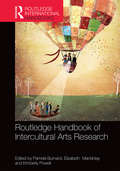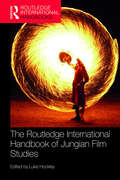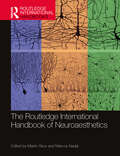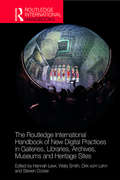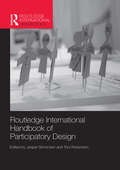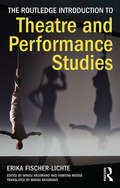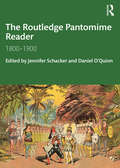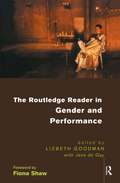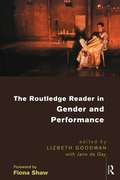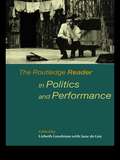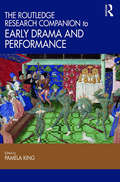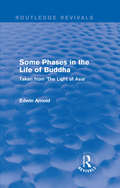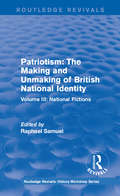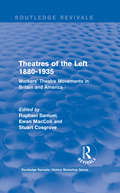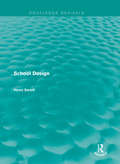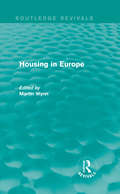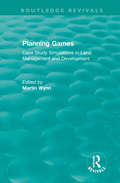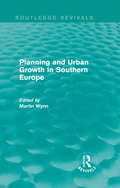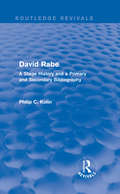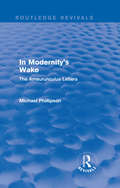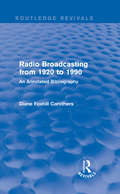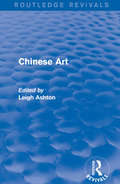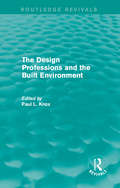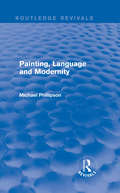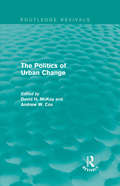- Table View
- List View
The Routledge International Handbook of Intercultural Arts Research (Routledge International Handbooks of Education)
by Kimberly Powell Elizabeth Mackinlay Pamela BurnardFor artists, scholars, researchers, educators and students of arts theory interested in culture and the arts, a proper understanding of the questions surrounding ‘interculturality’ and the arts requires a full understanding of the creative, methodological and interconnected possibilities of theory, practice and research. The International Handbook of Intercultural Arts Research provides concise and comprehensive reviews and overviews of the convergences and divergences of intercultural arts practice and theory, offering a consolidation of the breadth of scholarship, practices and the contemporary research methodologies, methods and multi-disciplinary analyses that are emerging within this new field.
The Routledge International Handbook of Jungian Film Studies (Routledge International Handbooks)
by Luke HockleyThe Routledge International Handbook of Jungian Film Studies weaves together the various strands of Jungian film theory, revealing a coherent theoretical position underpinning this exciting recent area of research, while also exploring and suggesting new directions for further study. The book maps the current state of debates within Jungian orientated film studies and sets them within a more expansive academic landscape. Taken as a whole, the collection shows how different Jungian approaches can inform and interact with a broad range of disciplines, including literature, digital media studies, clinical debates and concerns. The book also explores the life of film outside cinema - what is sometimes termed ‘post-cinema’ - offering a series of articles exploring Jungian approaches to cinema and social media, computer games, mobile screens, and on-line communities. The Routledge International Handbook of Jungian Film Studies represents an essential resource for students and researchers interested in Jungian approaches to film. It will also appeal to those interested in film theory more widely, and in the application of Jung’s ideas to contemporary and popular culture.
The Routledge International Handbook of Neuroaesthetics (Routledge International Handbooks)
by Martin Skov Marcos NadalThe Routledge International Handbook of Neuroaesthetics is an authoritative reference work that provides the reader with a wide-ranging introduction to this exciting new scientific discipline. The book brings together leading international academics to offer a well-balanced overview of this burgeoning field while addressing two questions central to the field: how the brain computes aesthetic appreciation for sensory objects and how art is created and experienced. The editors, Martin Skov and Marcos Nadal, have compiled a neuroscientific, physiological, and psychological overview of the systems underlying the evaluation of sensory objects and aesthetic appreciation. Covering a variety of art forms mediated by vision, audition, movement, and language, the handbook puts forward a critical review of the current research to explain how and why perceptual and emotional processes are essential for art production. The work also unravels the interaction of art with expectations, experience and knowledge and the modulation of artistic appreciation through social and contextual settings, eventually bringing to light the potential of art to influence mental states, health, and well-being. The concepts are presented through research on the neural processes enabling artistic creativity, artistic expertise, and the evolution of symbolic cognition. This handbook is a compelling read for anyone interested in making a first venture into this exciting new area of study and is best suited for students and researchers in the fields of neuroaesthetics, perceptual learning, and cognitive psychology.
The Routledge International Handbook of New Digital Practices in Galleries, Libraries, Archives, Museums and Heritage Sites (Routledge International Handbooks)
by Hannah Lewi Wally Smith Dirk Vom Lehn Steven CookeThe Routledge International Handbook of New Digital Practices in Galleries, Libraries, Archives, Museums and Heritage Sites presents a fascinating picture of the ways in which today's cultural institutions are undergoing a transformation through innovative applications of digital technology. With a strong focus on digital design practice, the volume captures the vital discourse between curators, exhibition designers, historians, heritage practitioners, technologists and interaction designers from around the world. Contributors interrogate how their projects are extending the traditional reach and engagement of institutions through digital designs that reconfigure the interplay between collections, public knowledge and civic society. Bringing together the experiences of some of today’s most innovative cultural institutions and thinkers, the Handbook provides refreshingly new ideas and directions for the exciting digital challenges and opportunities that lie ahead. As such, it should be essential reading for academics, students, designers and professionals interested in the production of culture in the post-digital age.
Routledge International Handbook of Participatory Design (Routledge International Handbooks)
by Jesper Simonsen Toni RobertsonParticipatory design is about the direct involvement of people in the co-design of the technologies they use. Its central concern is how collaborative design processes can be driven by the participation of the people affected by the technology designed. Embracing a diverse collection of principles and practices aimed at making technologies, tools, environments, businesses, and social institutions more responsive to human needs, the International Handbook of Participatory Design is a state-of-the-art reference handbook for the subject. The Handbook brings together a multidisciplinary and international group of highly recognized and experienced experts to present an authoritative overview of the field and its history and discuss contributions and challenges of the pivotal issues in participatory design, including heritage, ethics, ethnography, methods, tools and techniques and community involvement. The book also highlights three large-scale case studies which show how participatory design has been used to bring about outstanding changes in different organizations. The book shows why participatory design is an important, highly relevant and rewarding area for research and practice. It will be an invaluable resource for students, researchers, scholars and professionals in participatory design.
The Routledge Introduction to Theatre and Performance Studies
by Erika Fischer-Lichte Minou Arjomand Ramona MosseErika Fischer-Lichte's introduction to the discipline of Theatre and Performance Studies is a strikingly authoritative and wide ranging guide to the study of theatre in all of its forms. Its three-part structure moves from the first steps in starting to think about performance, through to the diverse and interrelated concerns required of higher-level study: Part 1 - Central Concepts for Theatre and Performance Research - introduces the language and key ideas that are used to discuss and think about theatre: concepts of performance; the emergence of meaning; and the theatrical event as an experience shared by actors and spectators. Part 1 contextualizes these concepts by tracing the history of Theatre and Performance Studies as a discipline. Part 2 - Fields, Theories and Methods - looks at how to analyse a performance and how to conduct theatre-historiographical research. This section is concerned with the 'doing' of Theatre and Performance Studies: establishing and understanding different methodological approaches; using sources effectively; and building theoretical frameworks. Part 3 - Pushing Boundaries - expands on the lessons of Parts 1 and 2 in order to engage with theatre and performance in a global context. Part 3 introduces the concept of 'interweaving performance cultures'; explores the interrelation of theatre with the other arts; and develops a transformative aesthetics of performance. Case studies throughout the book root its theoretical discussion in theatrical practice. Focused accounts of plays, practitioners and performances map the development of Theatre and Performance Studies as an academic discipline, and of the theatre itself as an art form. This is the most comprehensive and sophisticated introduction to the field available, written by one of its foremost scholars.
The Routledge Pantomime Reader: 1800-1900
by Jennifer SchackerThe Routledge Pantomime Reader is the first anthology to document this entertainment genre—one of the most distinctive and ubiquitous in nineteenth-century Britain. Across ten different shows, readers witness pantomime’s development from a highly improvisational venue for clowning, dance, and musical parody to a complex amalgamation of physical and topical comedy, stage wizardry, scenic spectacle, satire, and magical mayhem. Combining well-known tales such as "Cinderella", "Aladdin", and "Jack and the Beanstalk" with the lesser-known plotlines of "Peter Wilkins" and "The Prince of Happy Land", the book demonstrates not only how popular narratives were adapted to the current moment, but also how this blend of high and low entertainment addressed a whole range of social and cultural anxieties. Along with carefully annotated scripts, readers will find detailed introductions to all of the collected pantomimes and supplementary materials such as reviews, reminiscences, and a host of visual materials that bring these neglected entertainments to life. The plays collected here provide a remarkable perspective on the history of sexuality, class, and race during a period of vast imperial expansion and important social upheaval in Britain itself—essential reading for students and scholars of theatre history and popular performance.
The Routledge Reader in Gender and Performance
by Lizbeth Goodman Jane De GayThe Routledge Reader in Gender and Performance presents the most influential and widely-known, critical work on gender and performing arts, together with exciting and provocative new writings. It provides systematically arranged articles to guide the reader from topic to topic, and specially linked articles by scholars and teachers to explain key issues and put the extracts in context. This comprehensive volume:* reviews women's contributions to theatre history* includes contributions from many of the top academics in this discipline* examines how theatre has represented women over the centuries* introduces readers to major theoretical approaches and more complex questions about gender, the body and cross-dressing* offers an international perspective, including material from post-apartheid South Africa and post-communist Russia.
Routledge Reader in Gender and Performance
by Lizbeth Goodman Jane De GayThe book presents some of the most influential and widely known work on gender and performing arts, together with exciting and provocative new writings in the field.
The Routledge Reader in Politics and Performance
by Jane De Gay Lizbeth GoodmanThe Routledge Reader in Politics and Performance brings together for the first time a comprehensive collection of extracts from key writings on politics, ideology, and performance. Taking an interdisciplinary approach to the subject, and including new writings from leading scholars, the book provides material on: * post-coloniality and performance theory and practice * critical theories and performance * intercultural perspectives * power, politics and the theatre * sexuality in performance * live arts and the media * theatre games.
The Routledge Research Companion to Early Drama and Performance (Routledge Companions)
by Pamela KingThe study of early drama has undergone a quiet revolution in the last four decades, radically altering critical approaches to form, genre, and canon. Drawing on disciplines from art history to musicology and reception studies, The Routledge Research Companion to Early Drama and Performance reconsiders early "drama" as a mixed mode entertainment best studied not only alongside non-dramatic texts, but also other modes of performance. From performance before the playhouse to the afterlife of medieval drama in the contemporary avant-garde, this stunning collection of essays is divided into four sections: Northern European Playing before the Playhouse; Modes of Production and Reception; Reviewing the Anglophone Tradition; The Long Middle Ages Offering a much needed reassessment of what is generally understood as "English medieval drama", The Routledge Research Companion to Early Drama and Performance provides an invaluable resource for both students and scholars of medieval studies.
Routledge Revivals: Taken from 'The Light of Asia' (Routledge Revivals)
by Edwin ArnoldFirst published in 1915, this book presents a dramatization of part ofthe author's The Light of Asia. The original text represents one of the first successful attempts to popularise Buddhism and its founder Gautama Buddha — presenting his life, teachings and philosophy in verse poetry. This adaptation dramatizes part of the The Light of Asia and includes staging instructions, properties required, illustrative drawings of suggested costumes, and incidental music composed specifically for the piece. This book will be of interest to students of Indian and Buddhist literature — and how this has interacted with the West — as well as students of drama.
Routledge Revivals: Volume III: National Fictions (Routledge Revivals: History Workshop Series)
by Raphael SamuelFirst published in 1989, this is the third of three volumes exploring the changing notions of patriotism in British life from the thirteenth century to the late twentieth century and constitutes an attempt to come to terms with the power of the national idea through a historically informed critique. This volume studies some of the leading figures of national myth, such as Britannia and John Bull. One group of essays looks at the idea of distinctively national landscape and the ways in which it corresponds to notions of social order. A chapter on the poetry of Edmund Spenser explores metaphorical representations of Britain as a walled garden, and the idea of an enchanted national space is taken up in a series of essays on literature, theatre and cinema. An introductory piece charts some of the startling changes in the image of national character, from the seventeenth-century notion of the English as the most melancholy people in Europe, to the more uncertain and conflicting images of today.
Routledge Revivals: Workers' Theatre Movements in Britain and America (Routledge Revivals: History Workshop Series #5)
by Raphael Samuel Ewan Maccoll Stuart CosgroveFirst published in 1985, this book examines how workers theatre movements intended their performances to be activist — perceiving art as a weapon of struggle and enlightenment — and an emancipatory act. An introductory study relates left-wing theatre groupings to the cultural narratives of contemporary British socialism. The progress of the Workers’ Theatre Movement (1928-1935) is traced from simple realism to the most brilliant phase of its Russian and German development alongside which the parallel movements in the United States are also examined. A number of crucial texts are reprints as well as stage notes and glimpses of the dramaturgical controversies which accompanied them.
Routledge Revivals: School Design (1994) (Routledge Revivals)
by Henry SanoffEducators often overlook the positive impact of changing the environment of the school itself when considering how to improve the quality of education. First published in 1994, School Design shows how to create more effective schools through a design process that involves teachers, students, parents, administrators, and architects. It reveals how to create school environments that develop the whole child, instil enthusiasm for learning, and encourage positive social relationships. Readers discover how to integrate design research, design participation, and design development to optimize school settings. Using a number of case studies, detailed practical methods show how to: Link behavioural objectives to spatial needs Achieve spatial efficacy without compromising education Match children’s developmental needs to facility requirements Promote greater variety in physical facilities to accommodate various teaching and learning styles Gain more valuable feedback from teachers, parents, students, and local citizens on building performance. In response to tight school budgets, Henry Sanoff discusses how relatively minor design modifications can have a major positive effect on school performance. This path-breaking volume will provide architects, teachers, and school administrators with a wide array of insights into creating spaces that promote better learning.
Routledge Revivals: Housing In Europe (1984) (Routledge Revivals)
by Martin WynnFirst published in 1984, this book presents a survey of housing problems in various European countries and how individual states have responded. Each chapter begins by surveying the problem in each country since the Second World War, before going on to outline the roles fulfilled by national housing agencies and local authorities, as well as assessing the impact of housing policies on society and on the physical shape of cities. It considers whether housing policies have succeeded or failed and how the ‘housing problem’ has changed over time. Each chapter draws out lessons that can be learned for the future from each country’s past handling of the problem. This book will be a useful reference for those interested in housing, including planners, geographers, economists, sociologists or policy-makers.
Routledge Revivals: Case Study Simulations in Land Management and Development (Routledge Revivals)
by Martin WynnFirst published in 1985, this book presents seven games for use in the teaching and study of planning, urban studies or land administration. These simulations are all built on researched case studies and deal with a number of critical planning and developmental issues; for each one the book provides full operational instructions and all gaming materials required. The games in this volume cover a number of scenarios, including the design of a mixed retail, social and service centre in a new city, new development in a run-down inner city area, rehabilitation or renewal of housing, tourist development in the Mediterranean and a new cross-town motorway in a major north American city. In addition, sets of guidelines for those wishing to design and operate their own case study simulations are also included. This book will be a valuable resource for students of town planning or urban development who are keen to gain ‘hands-on’ experience of using the professional skills they have acquired on their courses.
Routledge Revivals: Planning And Urban Growth In Southern Europe (1984) (Routledge Revivals)
by Martin WynnFirst published in 1984, this book addresses key questions about the pattern of urban development in Southern Europe and the mechanisms employed to control and regulate this development in individual countries. It examines five countries – Greece, Italy, Portugal, Spain and Turkey – that have experienced different scales and rates of urbanization and industrialization. It identifies common problems arising from these processes, as well as the successes and failures of the planning policies employed to regulate development. This book will be of great value to geographers interested in Southern Europe and urban and regional planners interested in comparative patterns of development.
Routledge Revivals (1988): A Stage History and a Primary and Secondary Bibliography
by Philip C. KolinIn the twenty years that preceded the publication of this book in 1988, David Rabe was in the vanguard of playwrights who shaped American theatre. As the first full-length work on Rabe, this book laid the groundwork for later critical and biographical studies. The first part consists of an essay that covers three sections: a short biography, a summary and evaluation of his formative journalism for the New Haven Register, and a detailed and cohesive stage history of his work. The second part presents the most comprehensive and authoritative primary bibliography of Rabe to date, with the third section containing a secondary bibliography — including a section on biographical studies.
Routledge Revivals (1989): The Ameurunculus Letters
by Michael PhillipsonFirst published in 1988, this book attempts to tackle the problem of how to write about art, culture, and the issues of postmodernism in a style appropriate to what is being claimed. The letters are written on art’s behalf to a range of institutions and individuals, and have as their recurring concern the relation between art, culture and representation — both art as representation and how art is represented to, and for, the surrounding culture. They explore the context and viability of art through a range of themes, including writing, the aestheticisation of everyday life, style, design pleasure, fragmentation, hyphenation, technology, and the museum — drawing on materials from the visual arts, music, literature, post-structuralism, contemporary criticism, philosophy, and sociology.
Routledge Revivals (1991): An Annotated Bibliography
by Diane Foxhill CarothersFirst published in 1991, this book presents a comprehensive annotated bibliography of radio broadcasting. Its eleven chapter-categories cover almost the entire range of radio broadcasting — with the exception of radio engineering due to its technical complexity although some of the historical volumes do encompass aspects, thus providing background material. Entries are primarily restricted to published books although a number of trade journals and periodicals are also included. Each entry includes full bibliographic information, including the ISBN or ISSN where available, and an annotation written by the author with the original text in hand.
Routledge Revivals: Chinese Art (1935)
by Leigh AshtonFirst published in 1935, this book was intended to provide westerners with a more definite and comprehensive understanding of Chinese Art and its achievements. Newly available opportunities to study authentic examples, such as the Royal Academy exhibition that provided the impetus for this volume, allowed for greater opportunities to conduct in-depth examination than had previously been possible. Following an introduction giving an overview of Chinese art and its history in the west, six chapters cover painting and calligraphy, sculpture and lacquer, ‘the potter’s art’, bronzes and cloisonné enamel, jades, and textiles — supplemented by a chronology of Chinese epochs, a selected bibliography and 25 images.
Routledge Revivals: The Design Professions and the Built Environment (Routledge Revivals)
by Paul L. KnoxFirst published in 1988, this book argues that discussions of urban development often neglect to consider that much of the urban environment is designed by architects and planners, and that the particular world-view of architects and planners is crucial for the way proposals are taken up, modified and carried out. The author explores the world-view of architects and planners, considering their approach to design and the factors which influence this — work patterns, career paths and the firms in which they operate. The author also studies their place in the political decision-making process as it affects urban questions and then explores how architects and planners roles are changing.
Routledge Revivals: Painting, Language and Modernity (1985)
by Michael PhillipsonFirst published in 1985, this book draws together the author’s artistic with analytical practices which had been developed over many years of sociological enquiry. It interprets a ‘work of art’ as a site on which a viewer or critic is invited to share in questioning celebration of the painting itself. The author reassesses modern painting’s relation to its own origins and to tradition in light of the emergence of ‘postmodern’ practice — exploring its engagement of fundamental questions about language and being. Also assessed is the relevance of the metaphors of writings and Reading to an understanding of painting and viewing practices — looking at painters’ writings as well as phenomenological and post-structuralist writers.
Routledge Revivals: The Politics of Urban Change (1979)
by David H. McKay Andrew W. CoxFirst published in 1979, this book examines key planning policy areas such as land use planning, land values, housing and slum clearance, urban transport, industrial and regional economic location policies, and policies inner city policies to explain why particular policies have been adopted at particular times — assessing the role of political parties, bureaucrats and interests in setting the national policy agenda. Policy is also placed in the broader economic and social context and the question of whether, given contemporaneous constraints, a coherent national urban policy is possible is examined. Its focus on political parties’ role in urban change at the start of Thatcher-era upheavals makes this book especially valuable to students of urban sociology and the history of planning.
